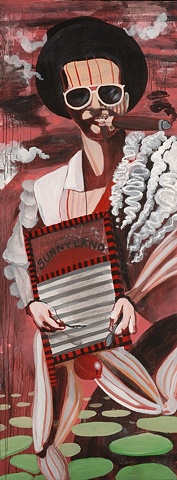Chicago, IL
19 May 2007
Eduardo de Soignie’s large-scale paintings on panel and paper evidence an unusually careful ability to layer heretofore unrelated aesthetic traditions, from the ruffled collars and festival masks of colonial Spanish portraiture, to the bamboo and pagodas of classical Chinese landscapes, to the fabulous Afros and sunglasses of 1970s album covers. To look at these paintings demands therefore that the viewer use her eyes archeologically, to sift through various strata in an effort to unearth unexpected finds that, because they are all buried in the same place, must somehow be related to one another. Visual interconnectedness is achieved by the collage technique of montage and superposition, as by more painterly effects, some of them exquisite, of abstract mark making. The task of the archaeologist-viewer is thus twofold: to enjoy the pleasures of letting rich earth pass through her fingers, but also to sort out that which she finds there, to think about where it comes from and how it came to be there.
—Lori Waxman
